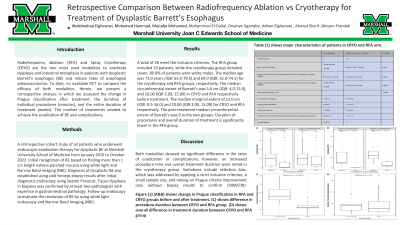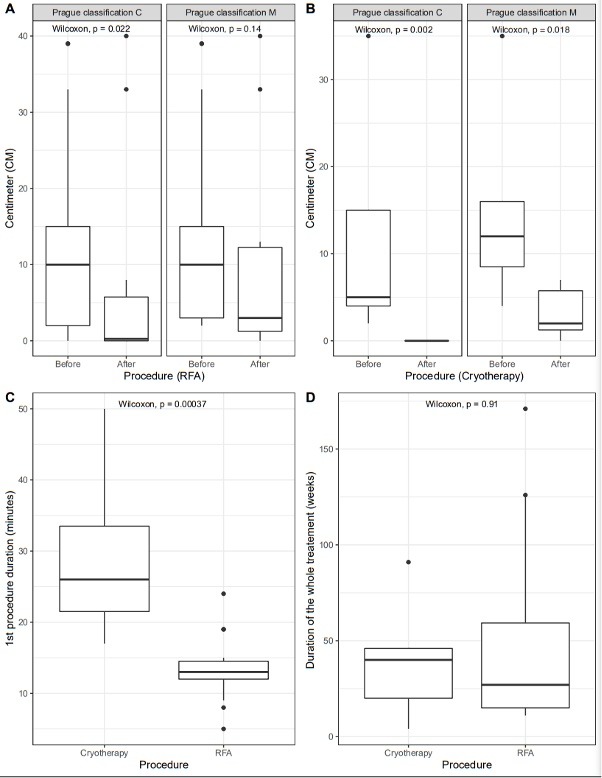Tuesday Poster Session
Category: Esophagus
P3241 - Retrospective Comparison Between Radiofrequency Ablation vs Cryotherapy for Treatment of Dysplastic Barrett’s Esophagus
Tuesday, October 24, 2023
10:30 AM - 4:00 PM PT
Location: Exhibit Hall

Has Audio
- AE
Adnan Elghezewi, MD
Marshall University Joan C. Edwards School of Medicine
Huntington, WV
Presenting Author(s)
Abdelwahap Elghezewi, MD1, Mohamed Hammad, MD1, Mujtaba Mohamed, MBBS2, Mohammed El-Dallal, MD3, Onyinye Ugonabo, MD3, Adnan Elghezewi, MD3, Ahmed Sherif, MD1, Wesam Frandah, MD3
1Marshall University, Huntington, WV; 2Joan C. Edwards School of Medicine, Huntington, WV; 3Marshall University Joan C. Edwards School of Medicine, Huntington, WV
Introduction: Radiofrequency ablation (RFA) and Spray Cryotherapy (CRYO) are the two most used modalities to eradicate dysplasia and intestinal metaplasia in patients with dysplastic Barrett’s esophagus (BE) and reduce rates of esophageal adenocarcinoma. To date, no available RCT to compare the efficacy of both modalities. Herein, we present a retrospective analysis in which we assessed the change in Prague classification after treatment, the duration of individual procedures (minutes), and the entire duration of treatment (weeks). The number of treatments needed to achieve the eradication of BE and complications.
Methods: A retrospective cohort study of all patients who underwent endoscopic eradication therapy for dysplastic BE at Marshall University School of Medicine from January 2016 to October 2022. Initial recognition of BE based on finding more than 1 cm length salmon patched mucosa using white light and Narrow Band imaging (NBI). Diagnosis of Dysplastic BE was established using cold forceps biopsy results after initial diagnostic endoscopy using Seattle Protocol. Tissue dysplasia in biopsies was confirmed by at least two pathologists with expertise in gastrointestinal pathology. Follow-up endoscopy to evaluate the resolution of BE by using white light endoscopy and Narrow Band Imaging (NBI).
Results: A total of 26 meet the inclusion criterion. The RFA group included 19 patients, while the cryotherapy group included seven. 80.8% of patients were white males. The median age was 73.0 years (IQR: 63.0-79.5) and 69.0 (IQR: 51.0-74.5) for the cryotherapy and RFA groups, respectively. The median circumferential extent of Barrett’s was 5.0 cm (IQR: 4.0-15.0), and 10.00 (IQR 2.00, 15.00) in CRYO and RFA respectively before treatment. The median marginal extent of 12.0 cm (IQR: 8.5-16.0) and 10.00 (IQR 3.00, 15.00) for CRYO and RFA respectively. The post-treatment median circumferential extent of Barrett’s was 0 in the two groups. Duration of procedures and overall duration of treatment is significantly lower in the RFA group.
Discussion: Both modalities showed no significant difference in the rates of eradication or complications; however, an increased procedure time and overall treatment duration were noted in the cryotherapy group. limitations include selection bias, which was addressed by applying a strict inclusion criterion, a small sample size, and relying on Prague criteria improvement only without biopsy results to confirm CRIM/CRD.

Disclosures:
Abdelwahap Elghezewi, MD1, Mohamed Hammad, MD1, Mujtaba Mohamed, MBBS2, Mohammed El-Dallal, MD3, Onyinye Ugonabo, MD3, Adnan Elghezewi, MD3, Ahmed Sherif, MD1, Wesam Frandah, MD3. P3241 - Retrospective Comparison Between Radiofrequency Ablation vs Cryotherapy for Treatment of Dysplastic Barrett’s Esophagus, ACG 2023 Annual Scientific Meeting Abstracts. Vancouver, BC, Canada: American College of Gastroenterology.
1Marshall University, Huntington, WV; 2Joan C. Edwards School of Medicine, Huntington, WV; 3Marshall University Joan C. Edwards School of Medicine, Huntington, WV
Introduction: Radiofrequency ablation (RFA) and Spray Cryotherapy (CRYO) are the two most used modalities to eradicate dysplasia and intestinal metaplasia in patients with dysplastic Barrett’s esophagus (BE) and reduce rates of esophageal adenocarcinoma. To date, no available RCT to compare the efficacy of both modalities. Herein, we present a retrospective analysis in which we assessed the change in Prague classification after treatment, the duration of individual procedures (minutes), and the entire duration of treatment (weeks). The number of treatments needed to achieve the eradication of BE and complications.
Methods: A retrospective cohort study of all patients who underwent endoscopic eradication therapy for dysplastic BE at Marshall University School of Medicine from January 2016 to October 2022. Initial recognition of BE based on finding more than 1 cm length salmon patched mucosa using white light and Narrow Band imaging (NBI). Diagnosis of Dysplastic BE was established using cold forceps biopsy results after initial diagnostic endoscopy using Seattle Protocol. Tissue dysplasia in biopsies was confirmed by at least two pathologists with expertise in gastrointestinal pathology. Follow-up endoscopy to evaluate the resolution of BE by using white light endoscopy and Narrow Band Imaging (NBI).
Results: A total of 26 meet the inclusion criterion. The RFA group included 19 patients, while the cryotherapy group included seven. 80.8% of patients were white males. The median age was 73.0 years (IQR: 63.0-79.5) and 69.0 (IQR: 51.0-74.5) for the cryotherapy and RFA groups, respectively. The median circumferential extent of Barrett’s was 5.0 cm (IQR: 4.0-15.0), and 10.00 (IQR 2.00, 15.00) in CRYO and RFA respectively before treatment. The median marginal extent of 12.0 cm (IQR: 8.5-16.0) and 10.00 (IQR 3.00, 15.00) for CRYO and RFA respectively. The post-treatment median circumferential extent of Barrett’s was 0 in the two groups. Duration of procedures and overall duration of treatment is significantly lower in the RFA group.
Discussion: Both modalities showed no significant difference in the rates of eradication or complications; however, an increased procedure time and overall treatment duration were noted in the cryotherapy group. limitations include selection bias, which was addressed by applying a strict inclusion criterion, a small sample size, and relying on Prague criteria improvement only without biopsy results to confirm CRIM/CRD.

Figure: Figure (1) (A&B) shows change in Prague classification in RFA and CRYO groups before and after treatment. (C) shows difference in procedure duration between CRYO and RFA group. (D) shows overall difference in treatment duration between CRYO and RFA group.
Disclosures:
Abdelwahap Elghezewi indicated no relevant financial relationships.
Mohamed Hammad indicated no relevant financial relationships.
Mujtaba Mohamed indicated no relevant financial relationships.
Mohammed El-Dallal indicated no relevant financial relationships.
Onyinye Ugonabo indicated no relevant financial relationships.
Adnan Elghezewi indicated no relevant financial relationships.
Ahmed Sherif indicated no relevant financial relationships.
Wesam Frandah: Endo gastric solutions – Consultant. Olympus Medical – Consultant.
Abdelwahap Elghezewi, MD1, Mohamed Hammad, MD1, Mujtaba Mohamed, MBBS2, Mohammed El-Dallal, MD3, Onyinye Ugonabo, MD3, Adnan Elghezewi, MD3, Ahmed Sherif, MD1, Wesam Frandah, MD3. P3241 - Retrospective Comparison Between Radiofrequency Ablation vs Cryotherapy for Treatment of Dysplastic Barrett’s Esophagus, ACG 2023 Annual Scientific Meeting Abstracts. Vancouver, BC, Canada: American College of Gastroenterology.
